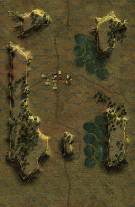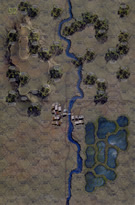
|
| Overall Rating, 5 votes |
|---|
|
2.8
|
| Scenario Rank: 847 of 940 |
| Parent Game | Changsha |
|---|---|
| Historicity | Historical |
| Date | 1941-12-24 |
| Start Time | 08:00 |
| Turn Count | 22 |
| Visibility | Day |
| Counters | 109 |
| Net Morale | 1 |
| Net Initiative | 3 |
| Maps | 2: 114, 92 |
| Layout Dimensions | 56 x 43 cm 22 x 17 in |
| Play Bounty | 187 |
| AAR Bounty | 147 |
| Total Plays | 4 |
| Total AARs | 5 |
| Battle Types |
|---|
| Exit the Battle Area |
| Inflict Enemy Casualties |
| River Crossing |
| Road Control |
| Conditions |
|---|
| Off-board Artillery |
| Scenario Requirements & Playability | |
|---|---|
| Changsha | Base Game |
| Counter Attack | Maps |
| Pusan Perimeter | Maps |
| Introduction |
|---|
|
The Japanese offensive at Changsha began with a southward advance by the 11th Army against the opposing Chinese 20th Army of the Yang Sen Group. The Chinese relied on the many rivers of Hunan Province to help stop against the invaders, providing ready-made defensive lines with very few bridges over them. While the Chinese IX War Zone had alerted its troops to expect a Japanese offensive, the Chinese infantrymen still could not match the firepower the Japanese could bring to bear. |
| Conclusion |
|---|
|
Despite plenty of warning, the Chinese seemed unprepared for the Japanese assault and fell back from the river line in some disarray. The Japanese marched after them, believing this yet another instance of their Chinese enemies melting away before superior firepower. But Pi Yueh, commander of the IX War Zone (army group), had prepared a series of lines to allow his troops to fall back steadily and maintain their resistance. |
| Japanese steamroller |
|---|
|
I've been playing a lot of Pacific scenarios in Guadalcanal and Saipan lately, and the way they have played out is typically with the US Marines hammering the Japanese. This was an interesting change of pace, in that in the first Changsha action the Japanese resemble a juggernaut that flatten the Chinese. It's a river crossing scenario, where both sides are composed entirely of infantry with hardly any bombardment capability at all. The Japanese have two battalions of infantry, with a company of engineers, to force a river crossing and achieve as many VCs as possible including inflicting 2X casualties or more, controlling the main road, and exiting 15+ steps off the far side of two maps. The Chinese have an infantry battalion to prevent this. In my play of the scenario, the Chinese deployed right along the river in company strongpoints. The critical defensive position was in the riverside town, defending the one bridge crossing point. The majority of the battalion was deployed east of town along the river, in the likeliest terrain for Japanese to try an engineer-assisted crossing. The west side of the map was heavily rice paddies, so a crossing attempt there wasn't likely and was only lightly covered. The Japanese largely obliged by committing 1st battalion, in column, to march up the main road and try to force the bridge crossing, while the engineer company would deploy with 2nd battalion in the east to try to cross the river the hard way. The Japanese approach march was brisk, with 1st battalion benefiting from the blind approach behind the town, but 2nd battalion started taking casualties as they descended on the river. In particular the engineering platoons were hard hit, so much so that the whole crossing in the east seemed to be thrown into chaos. Conversely in the town, a pair of Japanese HMG platoons that deployed to provide covering fire successfully routed most of the Chinese defenders and their Colonel, leaving the bridge unguarded! The Japanese poured across and raced deep into the Chinese position. The Chinese reacted swiftly, deploying their small reserve and beginning a retrograde maneuver to a secondary defensive line along a east-west ridge. For a few turns both sides' forces were mixed in a chaos of maneuver and assault, as the Chinese tried to stop the Japanese 1st battalion from driving ahead of their retreat. Three hours into the battle the Chinese, having sustained heavy casualties, had collapsed their position to the town south of the ridge, while a significant Japanese force of two companies marched past them toward the southern map edge and the remainder of the Japanese battalions formed up for an assault on the town. At this point I called the battle a major victory for Japan. This was a fun scenario, and I feel it could have been a greater challenge for the Japanese had it not been for that early bad break that left the town too exposed. That in turn caused the whole defense to unravel. The Japanese infantry had a huge advantage in assault, but the Chinese managed to use direct fire and their one mortar to good effect. A fun game, and remarkably full of movement for an all-infantry game. |
| 0 Comments |
| #1 Upper Shachiang Crossing |
|---|
|
If you like games with infantry combat, limited artillery support and you do not mind assembling the counters, then this DIY booklet is for you, unless the booklet is in Vassal. Not a bad set of scenarios, the Japanese are always outnumbered but are tough, especially in assault combat, against the more numerous Chinese forces. The Chinese are challenging to play, their morale is 7/6 or 7/5, you might find half your force disrupted or demoralized just when you have the Japanese on the brink of collapse and depending on the leaders you draw & flip you might have only one or two with any type of a modifier but there are a couple of good leaders that hold the Chinese forces together. All in all, enjoyed playing. If it is included with Vassal, it would be a good game for newer players trying to learn the system or even head-to-head with the veteran player playing the Chinese. |
| 0 Comments |
| Too little, too late! | ||||||||||||
|---|---|---|---|---|---|---|---|---|---|---|---|---|
While the Chinese Army isn't much good for much of anything..... The Chinese set up on the river, but the Japanese Army penetrated it in two places, at the bridge and near the West end of the mapboard. Once the penetration was made, the secondary fall back line was on the ridge line to the rear of the river. Essentially it was a protracted delaying action to keep the Japanese from getting off the South end of the playing area within the time allotted. Unfortunately, for the Japanese at any rate, they ended up two units short of their objective. A very slight win for the Chinese! |
||||||||||||
| 0 Comments |
| Japanese Wipeout! | ||||||||||||||
|---|---|---|---|---|---|---|---|---|---|---|---|---|---|---|
This massively unbalanced scenario was won in a virtual walk by the overwhelming firepower of the Nipponese force against the much weaker, and poorly equipped, Nationalist Chinese defenders. Even with a veteran PG opponent in command, there is very little that the Chinese can do to stop the Japanese surge across the river. I lost count of the step losses in this infantry-only brawl. This scenario gets a generous 2, although I enjoyed the win over a hard-fighting and crafty opponent. In all, it was A good learning scenario for the victorious Japanese. |
||||||||||||||
| 0 Comments |
| Christmas Eve Chinese Disaster | ||||||||||||||
|---|---|---|---|---|---|---|---|---|---|---|---|---|---|---|
This was a 5-session, unmitigated catastrophe for the defending Chinese that I ineptly-led, against the hard-charging Japanese Hordes commanded by Tankodactyl. He and I are both doing penance in this one, as neither side has any armor in this infantry-only, extended slugfest that took place on Christmas Eve. Others have reported that this one is a case of a Japanese juggernaut that can't help but demolish the hapless Chinese defense. Both sides drew crummy leaders, and together we threw 27 combat 7-die rolls! We used the FOW, smoke, consolidation and excess initiative optional rules. Then Chinese concentrated their weaker force in the town on the riverside, to defend the single bridge crossing, hoping that the Japanese would batter themselves to pieces in an opposed crossing, and creating the possibility of also stopping, or delaying, their most likely engineer-assisted crossing site via a concentrated defense. This was not to be, in spite of the defender's best - and very costly - efforts. The Japanese advantage in close assault did the trick over-and-over in our play-through. Japanese persistence eventually paid off and the bridge was taken after 6 turns. The nearby, engineer-assisted crossing was also successful for the men from Nippon during game turn 12, but this action was a much costlier undertaking for the attackers, as there was a senior leader decapitation thanks to an accurate mortar barrage in turn 11. The Chinese spent most of this scenario trying to recover morale for their many disrupted & demoralized units. After taking the riverside town, the Japanese relentlessly pursued the remaining Chinese who initially fell back on the nearby ridge line, and then to a neighboring town. The flood of Japanese units continued, and the game was beyond hope for the shattered Chinese side by the end of turn 18. Nevertheless, we fought on and finished the scenario. By the end of game turn 22, the Japanese had not only achieved a forced river crossing, but had inflicted the required number of Chinese casualties, controlled the main road, and had also exited 20 steps. There were only 9 steps of Chinese infantry and 4 leaders left at that point. The Japanese had lost a total of 9 steps and 7 leaders. The majority of the few Chinese combat successes in this one were in adjacent-hex firefights. I give this one a 2, mostly because there was a surprising amount of maneuver, for an infantry-centric scenario, and I enjoyed the antics of my rapidly-learning & now-victorious opponent. |
||||||||||||||
| 0 Comments |

 ChIn004
ChIn004 






















